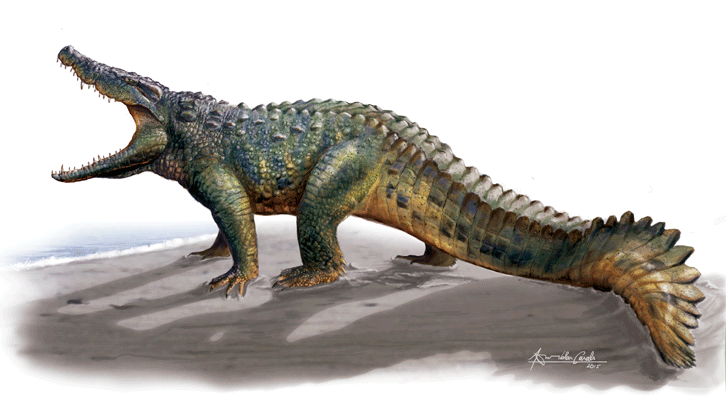When crocodiles ruled Europe

Throughout the Late Cretaceous, Europe was a large archipelago inhabited by a great diversity of dinosaurs, turtles, amphibians, squamates… and crocodiles.
The genus Allodaposuchus was an endemic (eusuchian) crocodile from Europe during this epoch. This genus was erected in 1928 by the famous Hungarian palaeontologist Baron Franz Nopcsa in order to describe the species Allodaposuchus precedens from Transylvania. Since then, many fragmentary crocodilian fossils found at Spain and France were identified as A. precedens, despite having significant morphological differences.
However, in the last decade, an almost complete skull and two other partial skeletons were discovered at pre-Pyrenean palaeontological sites from Aragón and Catalonia; and allowed to describe three new species in 2014 and 2015: Allodaposuchus hulki, A. palustris and A. subjuniperus. In the meantime, additional discoveries revealed more species closely related to Allodaposuchus, like Arenysuchus and Lohuecosuchus, coming from Huesca and Cuenca localities, respectively.
Nevertheless, a few studies questioned the validity of several species, arguing that all these taxa would simply represent a wide intraspecific variability (among individuals of the same species) of Allodaposuchus precedens, whose geographic distribution would be extended across the European archipelago completely.
In a recently published work in the journal Historical Biology, researchers from the Institut Català de Paleontologia (Universitat Autònoma de Barcelona) and the University of Iowa (USA), have reviewed the morphological variability showed by all these allodaposuchid species. Working on extinct species considerably limits the available sample. Consequently, the delimitation of fossil species rests on knowing the ranges of variation within modern lineages.
In this work, we have compared the morphological characters of skulls belonging to 8 different allodaposuchid species with ontogenetic (growth) series of living eusuchians (Alligator mississippiensis and Crocodylus niloticus), as well as a juvenile allodaposuchid skull. Our results showed that diagnostic characters for different allodaposuchid species are outside the ranges of variation for Alligator and Crocodylus series, and for ontogenetic changes estimated for allodaposuchids.
Our study supports the validity of the different published species and highlights a large diversity of this crocodilian group in the Cretaceous ecosystems.
Moreover, each species has different geographic, chronological and environmental factors associated, decreasing interspecific competition and promoting this high biodiversity. In addition, as a result of this review, a new hypothesis was proposed suggesting that some of these species might have evolved by paedomorphic processes, since juvenile characters were held in several adult specimens.
Catalan Institute of Paleontology Miquel Crusafont (ICP)
References
Blanco, A. & Brochu, C.A. Intra- and interspecific variability in allodaposuchid crocodylomorphs and the status of western European allodaposuchids. Historical Biology, 2017, 29, (4), 495-508. DOI: 10.1080/08912963.2016.1201081


